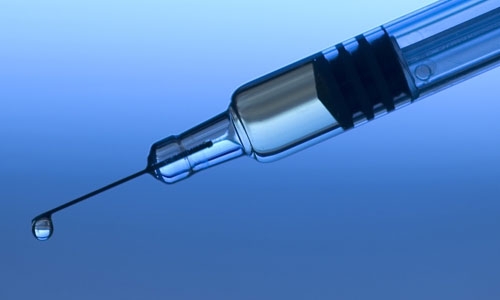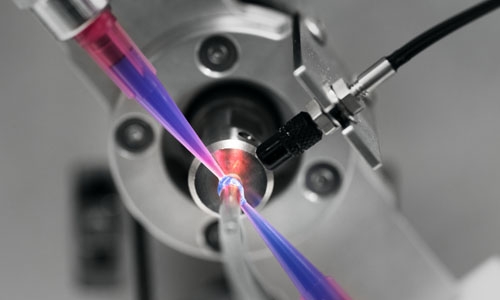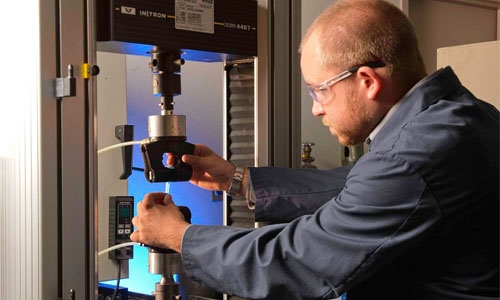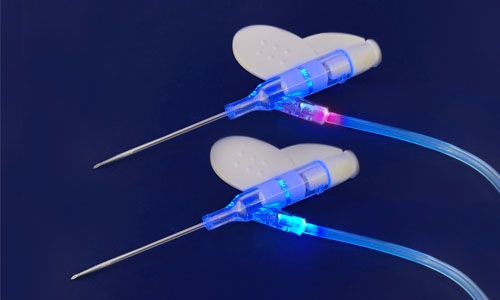Die wichtigsten Faktoren für Leistung, Sicherheit und Effizienz verstehen
In der Welt der Montage medizinischer Produkte steht unglaublich viel auf dem Spiel. Mediziner verlassen sich auf die Leistung, Sicherheit und Zuverlässigkeit von Geräten, die oft lebensrettend sind. Die richtige Klebeverbindung ist nicht nur für die Funktionalität des Produkts entscheidend, sondern auch für die Patientensicherheit. Die Auswahl des besten Klebstoffs aus einer Vielzahl verfügbarer Optionen kann entmutigend erscheinen, aber durch die Konzentration auf bestimmte Kriterien können Ingenieure und Hersteller eine fundierte, optimale Wahl treffen.
Die Chemie hinter der Auswahl medizinischer Klebstoffe
Bei der Montage von medizinischen Geräten aus Materialien wie technischen Kunststoffen (Polycarbonat, Acryl, ABS, Nylon) mit Metallen oder Glas wird die Klebstoffchemie zu einem entscheidenden Entscheidungskriterium. Es sind mehrere Klebstofftypen für unterschiedliche Materialkombinationen erhältlich: von lichthärtenden Acrylurethanen über Cyanacrylate, 1- oder 2-Komponenten-Epoxidharze bis hin zu Hybridsystemen, die thermische und lichthärtend Eigenschaften kombinieren.
Für Hersteller medizinischer Geräte ist eine der wichtigsten Überlegungen Biokompatibilität , da diese Geräte oft in direkten Kontakt mit dem menschlichen Körper kommen. Übliche Klebstoffe, die in diesem Bereich verwendet werden, wie lichthärtende Acrylaturethane, haben den Vorteil, dass sie bei Lichteinwirkung schnell aushärten, was sie ideal für transparente Kunststoffe macht. Cyanacrylate, flexible Urethane und starre Epoxide werden aufgrund der spezifischen Anforderungen an Klebung und Materialverträglichkeit ebenfalls häufig verwendet.
Viskosität: Die richtigen Fließeigenschaften finden
Die Viskosität, also der Fließwiderstand einer Flüssigkeit, ist ein weiterer wichtiger Parameter bei der Auswahl des geeigneten Klebstoffs für die Montage medizinischer Produkte. Der ausgewählte Klebstoff muss die Anforderungen des Montageprozesses erfüllen, sei es Vergießen, Füllen von Nuten oder Aufbringen präziser Raupen.
Klebstoffauftrag auf Tuben mit dem RotoSpense 360-Arbeitsstation
Für Ingenieure, die in der Herstellung medizinischer Geräte arbeiten, ist die Fähigkeit, die Viskosität ist der Schlüssel. Wenn beim Montageprozess Lücken gefüllt oder Vergießen werden müssen, ist eine Flüssigkeit mit niedrigerer Viskosität vorzuziehen. Für Anwendungen, die Klebstoffperlen oder -punkte erfordern, ist jedoch möglicherweise ein Material mit höherer Viskosität oder ein thixotropes Material besser geeignet. Thixotrope Materialien fließen unter Scherung leicht (wie während der Anwendung), verdicken sich jedoch, sobald die Scherung entfernt wird. Dieses Verhalten ist besonders nützlich, wenn eine präzise Platzierung des Klebstoffs entscheidend ist, da es ein unerwünschtes Ausbreiten verhindert.
Das Verständnis dieser Nuancen kann dazu beitragen, sicherzustellen, dass der ausgewählte Klebstoff sowohl die Leistungs- als auch die Herstellbarkeitsanforderungen des Geräts erfüllt.
Adhäsion: Optimierung von Klebkraft und Haltbarkeit
Bei der Auswahl des besten Klebstoffs müssen auch die spezifischen Hafteigenschaften berücksichtigt werden, die für die Leistung des Geräts erforderlich sind. Medizinische Geräte werden häufig strengen mechanischen Tests wie Überlappungsscher- oder Schälkrafttests unterzogen, um die Integrität der Verbindung unter den erwarteten Belastungen sicherzustellen.
Ein Anwendungsingenieur verwendet ein Instron für mechanische Tests.
Die Leistung eines Klebstoffs in solchen Tests hängt oft von den verwendeten Materialien, der Oberflächenvorbereitung und den Aushärtungsbedingungen ab. In einigen Fällen müssen Komponenten beschleunigte Alterung um den Langzeitgebrauch zu simulieren, insbesondere in rauen Umgebungen wie hohen Temperaturen oder Feuchtigkeit. Das Ausreizen der Grenzen dieser Alterungstests kann jedoch manchmal nach hinten losgehen, insbesondere bei Klebstoffen. Eine übermäßige Belastung durch extreme Bedingungen kann die Eigenschaften des Klebstoffs verändern und seine Flexibilität oder Dehnung verringern, was zu einem vorzeitigen Versagen im Einsatz führen kann.
Daher ist es wichtig, einen Klebstoff mit nachgewiesener Leistung in ähnlichen Anwendungen und Bedingungen auszuwählen, um Zuverlässigkeit und Langlebigkeit sicherzustellen.
Einfache Verarbeitung: Ein Schlüssel zur Fertigungseffizienz
Für Hersteller medizinischer Geräte ist Effizienz genauso wichtig wie Leistung. Klebstoffe können die Produktionsgeschwindigkeit und -kosten erheblich beeinflussen, insbesondere bei der Wahl zwischen 1-Komponenten- und 2-Komponenten-Systemen. 1-Komponenten-Klebstoffe wie Acrylat-Urethane werden oft aufgrund ihrer Einfachheit bevorzugt. Sie erfordern keine komplexen Dosiersysteme, haben weniger Verarbeitungsschritte und machen eine Systemspülung überflüssig, was sie ideal für die Produktion großer Stückzahlen macht.
Darüber hinaus spielt der Aushärtungsprozess eine entscheidende Rolle. Lichthärtende aushärtbare Klebstoffe kann die Produktionszeiten durch die Aushärtung nach Bedarf drastisch verkürzen. Es ist jedoch wichtig zu bewerten, wie einfach sich der Klebstoff in bestehende Produktionslinien integrieren lässt, unabhängig davon, ob die Montage manuell, halbautomatisch oder vollautomatisch erfolgt.
Hersteller müssen auch mögliche Störungen während der Produktion berücksichtigen, wie z. B. Bandstillstände oder Schwankungen der Klebstoffeigenschaften, die die Leistung beeinträchtigen könnten. Um Ausfallzeiten zu vermeiden und Ausschuss zu minimieren, muss sichergestellt werden, dass der Klebstoff diesen Herausforderungen gewachsen ist.
Biokompatibilität und regulatorische Aspekte
Bei medizinischen Geräteanwendungen ist Biokompatibilität unverzichtbar. Klebstoffe, die in diesen Baugruppen verwendet werden, müssen strenge Normen wie ISO 10993 oder USP Klasse VI erfüllen, um sicherzustellen, dass sie für den Einsatz in medizinischen Umgebungen sicher sind.
Diese Tests werden normalerweise an vollständig ausgehärteten Klebstoffproben durchgeführt, aber die Hersteller müssen auch eigene Tests durchführen, um zu bestätigen, dass der Klebstoff, wie er im Endprodukt verwendet wird, weiterhin konform ist. Faktoren wie Aushärtungszeit und -methode können die Biokompatibilität des Klebstoffs beeinflussen, daher ist eine genaue Überwachung des gesamten Montageprozesses erforderlich.
Die meisten Klebstoffe für medizinische Geräte sind kompatibel mit gängige Sterilisationsmethoden , wie Ethylenoxid (EtO) und Gammasterilisation. Die Beständigkeit gegenüber Autoklavieren ist jedoch häufig auf wenige Zyklen beschränkt, was je nach Verwendungszweck des Geräts eine Überlegung sein kann.
Qualitätssteigerung durch innovative Lösungen
Die Gewährleistung einer qualitativ hochwertigen Verbindung ist für die Zuverlässigkeit medizinischer Geräte von entscheidender Bedeutung. Einige moderne Klebstoffe enthalten fluoreszierend Mittel, die eine einfache Inspektion unter UV-Licht ermöglichen. Mit dieser Funktion können Hersteller sicherstellen, dass der Klebstoff die gesamte Klebelinie abdeckt und mögliche Defekte wie Luftblasen oder Hohlräume aufdeckt.
Zur Qualitätsprüfung werden Katheter mit fluoreszierendem Kleber verklebt.
Innovationen wie See-Cure-Technologie , fügen Sie eine zusätzliche Ebene der Qualitätskontrolle hinzu. Diese Klebstoffe ändern ihre Farbe, sobald sie vollständig ausgehärtet sind, sodass sich selbst bei komplexen Baugruppen leicht überprüfen lässt, ob der Klebstoff vollständig ausgehärtet ist. Diese Technologie hilft Herstellern, da sie dazu beiträgt, einen Sicherheitsfaktor in den Montageprozess einzubauen.
Umfassen® ist eine weitere neuartige Erfindung, die die patentierten Farbwechseltechnologien See-Cure und Ultra-Red® von Dymax in einem vereint. Wenn diese Technologie in Klebstoffe für medizinische Geräte von Dymax eingearbeitet wird, können Benutzer erkennen, wo ein lichthärtendes Material auf ein Bauteil aufgetragen wurde, und sicherstellen, dass es nach dem Übergang von hellblau zu farblos vollständig ausgehärtet ist.
Dank der Ultra-Red-Fluoreszenzfunktion bleibt der Klebstoff farblos, bis er UV-Licht geringer Intensität ausgesetzt wird. Dann fluoresziert er hellrot. Die leuchtende Farbe bildet einen starken Kontrast zu Kunststoffen und anderen Substraten, die von Natur aus blau fluoreszieren, und erleichtert so die visuelle Überprüfung der Klebelinie oder des beschichteten Bereichs. Die Ultra-Red®-Technologie erzeugt außerdem eine einzigartige Spektralsignatur, die zur Produktauthentifizierung verwendet werden kann.
Infolgedessen erzielen Hersteller durch die Encompass-Technologie Effizienzgewinne durch schnelles, bedarfsgesteuertes Aushärten mit einfacher Aushärtungsbestätigung und Klebelinieninspektion nach der Aushärtung.
Tatsächliche Kosten im Vergleich zum Preis: Den Wert von Klebstoffen verstehen
Die Kosten sind ein wichtiger Gesichtspunkt, aber es kann irreführend sein, sich ausschließlich auf den Preis pro Gramm Klebstoff zu konzentrieren. Die Gesamtkosten eines Klebstoffs hängen von Faktoren wie Abfallreduzierung, Verarbeitungseffizienz und Wartung ab. Beispielsweise kann ein teurerer aushärtbarer Klebstoff erhebliche Kosteneinsparungen bieten, da er die Aushärtungszeiten verkürzt und Ausfallzeiten minimiert.
Durch die Beurteilung des Klebstoffs im Kontext des gesamten Herstellungsprozesses wird sichergestellt, dass das ausgewählte Material nicht nur den niedrigsten Preis, sondern auch den besten Wert bietet.
Fazit: Beste Ergebnisse durch die Zusammenarbeit mit Experten
Bei der Auswahl des richtigen Klebstoffs für die Montage medizinischer Produkte müssen mehrere Faktoren abgewogen werden, darunter Chemie, Viskosität, Haftung und Verarbeitungsanforderungen. Durch die Zusammenarbeit mit einem Klebstofflieferanten, der die besonderen Herausforderungen der Herstellung medizinischer Geräte versteht, können Ingenieure eine zuverlässige Verbindung, optimale Leistung und langfristige Gerätesicherheit gewährleisten.
Labortechniker arbeiten an einem Projekt zusammen.





